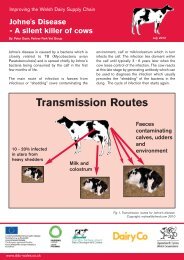Solar Photovoltaic Electricity Generation for Dairy Farms
Solar Photovoltaic Electricity Generation for Dairy Farms
Solar Photovoltaic Electricity Generation for Dairy Farms
You also want an ePaper? Increase the reach of your titles
YUMPU automatically turns print PDFs into web optimized ePapers that Google loves.
Gelli Aur <strong>Solar</strong> PV A5_13605 Practical sheep breeding 16/07/2012 09:02 Page 1<br />
Improving the Welsh <strong>Dairy</strong> Supply Chain<br />
<strong>Solar</strong> <strong>Photovoltaic</strong> <strong>Electricity</strong><br />
<strong>Generation</strong> <strong>for</strong> <strong>Dairy</strong> <strong>Farms</strong><br />
www.ddc-wales.co.uk
Gelli Aur <strong>Solar</strong> PV A5_13605 Practical sheep breeding 16/07/2012 09:02 Page 2<br />
<strong>Dairy</strong> Development Centre<br />
Gelli Aur<br />
Carmarthen<br />
Carmarthenshire<br />
SA32 8NJ<br />
Telephone: 01554 748570<br />
E-mail: ddc@colegsirgar.ac.uk<br />
www.ddc-wales.co.uk<br />
July 2012<br />
The <strong>Dairy</strong> Development Centre (DDC) acknowledges the contribution made by<br />
Farm Energy to the technical content of this booklet.<br />
This project has received funding through the Rural Development Plan <strong>for</strong> Wales 2007-2013 which<br />
is funded by the Welsh Government and the European Agricultural Fund <strong>for</strong> Rural Development.<br />
No part of this publication may be reproduced or transmitted in any <strong>for</strong>m by any means without the prior<br />
written consent of the <strong>Dairy</strong> Development Centre.<br />
Whilst all reasonable care has been taken in its preparation, no warranty is given as to its accuracy, no liability<br />
accepted <strong>for</strong> any loss or damage caused by reliance upon any statement in or omission from this publication.
Gelli Aur <strong>Solar</strong> PV A5_13605 Practical sheep breeding 16/07/2012 09:02 Page 3<br />
Contents<br />
What is the Feed-in Tariff scheme? 4<br />
Panel positioning 5<br />
Electrical installation issues 6<br />
Energy generation 6<br />
Other costs 7<br />
Financial considerations 7<br />
Application to dairy farming 8<br />
<strong>Solar</strong> PV electricity generation <strong>for</strong> dairy farms 3
Gelli Aur <strong>Solar</strong> PV A5_13605 Practical sheep breeding 16/07/2012 09:02 Page 4<br />
<strong>Generation</strong> of electricity from renewable sources has become more financially<br />
attractive since the introduction of generation subsidies called ‘Feed-in-tariffs’<br />
(FiTs).<br />
<strong>Photovoltaic</strong> (PV) panels are an attractive technology <strong>for</strong> farmers with buildings or<br />
areas of land suited to the installation of arrays. Installation is straight<strong>for</strong>ward and<br />
they are, <strong>for</strong> the most part, a ‘fit and <strong>for</strong>get’ solution to renewable energy generation.<br />
What is the Feed-in Tariff Scheme?<br />
A FiT is paid <strong>for</strong> each kilowatt-hour (kWh) of renewable electricity generated from<br />
an eligible renewable scheme. Rates are technology and size specific. Since the<br />
scheme started in 2011 the rates have been reviewed several times and further<br />
changes are expected in the future. The FiT rate is fixed at the time of project<br />
registration, index linked and are currently paid over a 25 year term, although this is<br />
likely to be reduced to 20 years in August 2012 to bring it in line with other<br />
renewable technologies.<br />
4 <strong>Solar</strong> PV electricity generation <strong>for</strong> dairy farms
Gelli Aur <strong>Solar</strong> PV A5_13605 Practical sheep breeding 16/07/2012 09:02 Page 5<br />
Panel positioning<br />
PV panels can be installed on a building roof - ideally south east to south west<br />
facing, with a 20 to 50 degree tilt. Ground-mounted systems are also available,<br />
which can be ideally placed and orientated. An area of approximately 8 m 2 per kW of<br />
peak capacity is required. So <strong>for</strong> example a 50 kW system would require 400 m 2 to<br />
accommodate between 180 and 250 PV panels on a roof. Panel weight is<br />
approximately 15 kg/m 2 . Any building older than 10 years may be rejected by an<br />
installer as not being robust enough to bear this load.<br />
The map represents the<br />
yearly sum of irradiation on<br />
horizontal and optimally<br />
angled panels, over a 10<br />
year average [kWh/m 2 ]. The<br />
same colour legend also<br />
represents potential solar<br />
electricity [kWh/kWp]<br />
generated by a 1kWp<br />
system per year with<br />
photovoltaic panels mounted<br />
at an optimum angle and<br />
assuming system<br />
per<strong>for</strong>mance of 75%.<br />
For a system to be<br />
successful there must be no<br />
overshadowing, <strong>for</strong> example<br />
from trees or other<br />
buildings.<br />
PVGIS European Communities, 2001-2008<br />
<strong>Solar</strong> PV electricity generation <strong>for</strong> dairy farms 5
Gelli Aur <strong>Solar</strong> PV A5_13605 Practical sheep breeding 16/07/2012 09:02 Page 6<br />
Electrical installation issues<br />
PV panels produce direct current (DC) so they use inverters to convert the output to<br />
mains voltage - alternating current (AC). The inverter is connected in parallel with<br />
the mains supply and energy generated either<br />
displaces that which would normally be<br />
CASE STUDY<br />
purchased, or is exported when on-site<br />
generation is greater than site demand. A<br />
‘protection’ system is required to prevent the<br />
system back-feeding into the grid should the<br />
grid fail.<br />
The electricity supply should be at least 1.5<br />
times larger than the maximum PV array output<br />
i.e. 15 kilovolt-ampere (kVa) <strong>for</strong> a 10 kilowattpeak<br />
(kWp) system. For systems over 15kWp<br />
the electricity supply will probably need to be<br />
three-phase. If you have to upgrade the supply,<br />
the distribution network operator will charge<br />
you <strong>for</strong> the upgrade and this can be expensive.<br />
Energy generation<br />
PV cannot be regarded as a means to energy<br />
self-sufficiency as it only operates during<br />
daylight hours and its output is dependent on<br />
the elevation of the sun and cloud cover.<br />
Roughly speaking a typical photovoltaic system<br />
will produce an average of about 9% of its<br />
theoretical maximum output in the UK. There is<br />
a published Standard Assessment Procedure<br />
(SAP) which will estimate the likely output of a<br />
system depending on its rating, latitude and<br />
Mr and Mrs Price from Brecon installed a<br />
solar PV system on the roof of one of their<br />
farm buildings in March 2012.<br />
Mr Price said: “We knew that we wanted to<br />
install some <strong>for</strong>m of renewable technology<br />
and solar PV fitted our needs. A local<br />
company did the installation and they were<br />
very professional. To date we have<br />
generated almost 1,700kWh of electricity<br />
which has reduced our electricity bill by<br />
around £105. We are very pleased with the<br />
system and are happy with the investment<br />
that we have made.”<br />
Income plus savings <strong>for</strong> the period March –<br />
July 2012 generated through FITs:<br />
<strong>Generation</strong> tariff = £736<br />
Export tariff = £26<br />
<strong>Electricity</strong> bill savings = £105<br />
Total income & savings to date = £867<br />
orientation. Please visit the following webpage address <strong>for</strong> further in<strong>for</strong>mation:<br />
http://www.decc.gov.uk/en/content/cms/emissions/sap/sap.aspx<br />
Output from panels will fall over time, at a rate of approximately 0.8% a year or 20%<br />
over their 25 year lifespan.<br />
6 <strong>Solar</strong> PV electricity generation <strong>for</strong> dairy farms
Gelli Aur <strong>Solar</strong> PV A5_13605 Practical sheep breeding 16/07/2012 09:02 Page 7<br />
Other costs<br />
Operation and maintenance costs are usually estimated at between 1% and 2% of the<br />
total installation cost per year. Although PV panels can last 25 years, the lifetime of<br />
the inverters (converts Direct Current to Alternating Current and are vital components<br />
of any PV system) will be shorter, possibly only 10 years.<br />
Financial considerations<br />
You should consider the energy related income that comes from the generation tariff<br />
(FiT); the excess energy that is exported to the national grid (export tariff) and the<br />
energy savings from not having to purchase as much energy from your dedicated<br />
energy supplier.<br />
The basic economics of a 49kW system installed in April 2012 are as follows:<br />
Installation costs £73,500<br />
Likely costs (2012) are £1,500<br />
per kW installed<br />
Average energy generated per year<br />
38,631kWh<br />
9% of theoretical maximum<br />
generation (average <strong>for</strong> the UK)<br />
Average annual income from FiT £8,460 Generated kWh at 21.9p/kWh<br />
Average annual income from power<br />
sold<br />
£898<br />
Assumed 75% export at<br />
3.1p/kWh<br />
Offset electricity value £1,060<br />
Average maintenance cost £1,600<br />
Annual value to the farm £8,818<br />
Assumed 25% own use at<br />
11p/kWh<br />
Cleaning, repair and system<br />
checks<br />
(FIT income) + (export) + (offset)<br />
- (maintenance)<br />
Payback 8.3 years (Install cost)/(annual value)<br />
<strong>Solar</strong> PV electricity generation <strong>for</strong> dairy farms 7
Gelli Aur <strong>Solar</strong> PV A5_13605 Practical sheep breeding 16/07/2012 09:02 Page 8<br />
Application to dairy farming<br />
Even at peak annual generation times, normal dairy farm energy use doesn’t suit solar<br />
energy production. On a typical dairy farm energy demand will be at its peak during<br />
morning and evening milking, where as solar energy production is at its peak around<br />
the middle of the day. Nevertheless, returns on investment can still be acceptable.<br />
It is possible to alter the operation of equipment such as water heaters and ice<br />
builders to make the best use of the PV generated electricity. By doing this the return<br />
on investment will be quicker as electricity used on farm from the PV is worth more<br />
than selling any unused energy back to the electricity supplier.<br />
Application of solar PV on dairy farms<br />
- normal energy use<br />
Electrical energy (KWh)<br />
00:00<br />
01:00<br />
02:00<br />
1st milking<br />
Milk collection<br />
2nd milking<br />
03:00<br />
04:00<br />
05:00<br />
06:00<br />
07:00<br />
08:00<br />
09:00<br />
10:00<br />
11:00<br />
Un-used<br />
solar energy<br />
13:00<br />
14:00<br />
15:00<br />
12:00<br />
Time<br />
16:00<br />
17:00<br />
18:00<br />
19:00<br />
20:00<br />
21:00<br />
normal energy use<br />
solar PV generation<br />
22:00<br />
23:00<br />
20:00<br />
Application of solar PV on dairy farms<br />
- revised energy use utilising solar PV<br />
Electrical energy (KWh)<br />
00:00<br />
01:00<br />
02:00<br />
1st milking<br />
Un-used<br />
solar energy<br />
Milk collection<br />
2nd milking<br />
03:00<br />
04:00<br />
05:00<br />
06:00<br />
07:00<br />
08:00<br />
09:00<br />
10:00<br />
11:00<br />
In order to maintain the best per<strong>for</strong>mance from the PV array, it is likely to need<br />
cleaning on a regular basis especially in the summer when dust can be an issue.<br />
Reference<br />
Šúri M., Huld T.A., Dunlop E.D. Ossenbrink H.A., 2007. Potential of solar electricity generation<br />
in the European Union member states and candidate countries. <strong>Solar</strong> Energy, 81, 1295–1305,<br />
http://re.jrc.ec.europa.eu/pvgis/.<br />
8 <strong>Solar</strong> PV electricity generation <strong>for</strong> dairy farms<br />
13:00<br />
14:00<br />
15:00<br />
12:00<br />
Time<br />
16:00<br />
17:00<br />
18:00<br />
19:00<br />
20:00<br />
21:00<br />
normal energy use<br />
solar PV generation<br />
22:00<br />
23:00<br />
20:00<br />
Graphs <strong>for</strong> illustration purposes only.











